Heretics ‘R Us. For eight years Church authorities searched for a reson not to burn the quarrelsome, opinionated, and altogether brilliant troublemaker. In the end he left them no choice…
…The Renaissance, as an age of transition, was not conducive to the building of great philosophical systems. It contained, in germinal form, the directive ideas of modern times, but under the guise of the past. Thinkers preferred to write in ancient Latin, and the style of their writing is also archaic. Under this external aspect, which smacks of antiquity, are hidden the signs of the next age. The most important representative of this new thought was Giordano Bruno. It is a new view of nature, in which nature is considered immanently, according to the forces inherent in it, and is accessible to experience and reason. These forces are considered as living ones, vital spirits, demons; everything is animate; the physical world has a soul. …
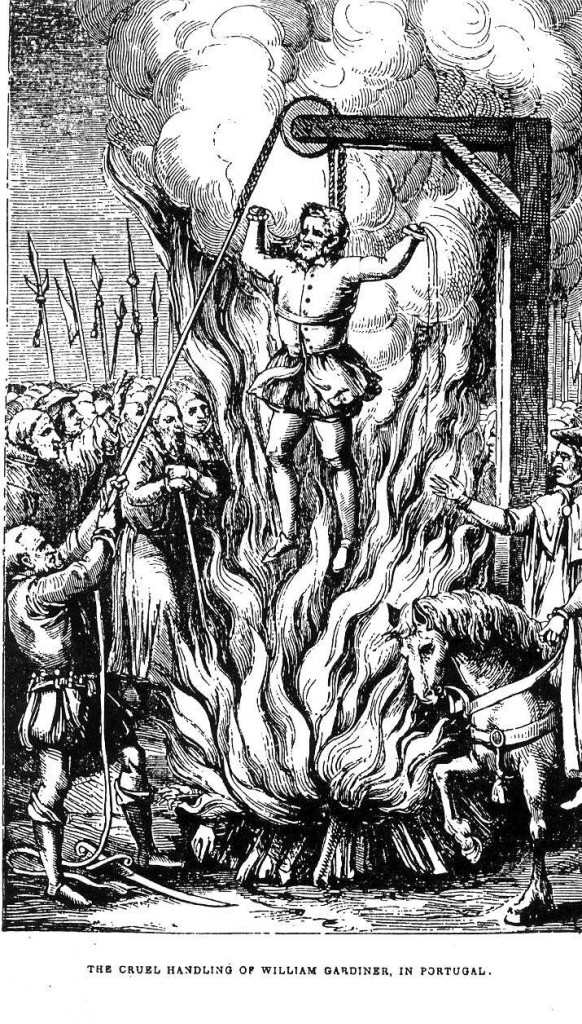
"In 1552 William Gardiner was executed while in Portugal where he was trussed up and lowered into the flames - an especially slow and painful death. The Scottish martyrs were possibly better treated in that their death was aided by tying bags of gunpowder to the body and a cord tied round the neck. The cord about the neck was originally intended, by Catholic doctrine, to throttle the prisoner before burning but it seemed to become more of a means of shutting off the the dying words and perhaps the screams of burning."
The year 1600 was to be a Holy Year, a year of universal jubilee. As their ancestors had done for the first Christian jubilee three centuries before, tens of thousands of pilgrims would flock to Rome. Traditionally, the celebration began on Christmas Eve, when the Porta Santa of St. Peter’s basilica, sealed at the close of he previous jubilee, was reopened by the pope. But on Christmas Exe, 1599, Clement VIII was confined to his bed with a severe case of gout, and the ceremony had to be postponed until December 31.
At six o’clock that evening , the pope was carried through the crowds to the steps of the basilica. While the Swiss guards beat back the pilgrims with their staves, the papal chair was lowered to the ground and the Supreme Pontiff helped to his feet. Taking little mincing steps and being careful not to bend his swollen knees, Clement eventually reached the Porta Santa, where he was handed a gilded hammer with which he struck the holy door three times. At the third stroke assistants removed the enclosing wall. Ignoring the excruciating pain the gesture must have cost him, th sixty-four year old pontiff sank to his knees to intone the Te Deum. During this Holy year, he appeared determined to set the world an example of piety and self-abnegation.
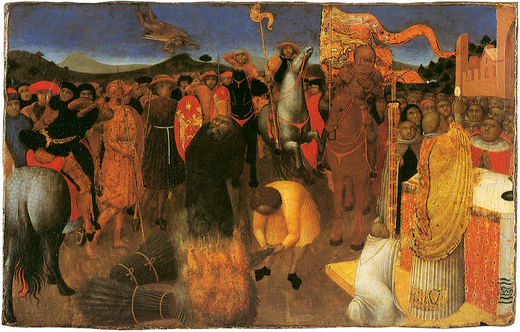
"Likewise, every person is somebody’s heretic. ”Heresy” means “choice.” Implicit in this label is the presumption of a bad choice, perhaps one that can lead to Hell. The presumptive proper choice, then, is conformity (a truly dirty word in my mind) to an ecclesiastical authority, often the Roman Catholic Magisterium, or a written creed or statement of faith, or someone’s literal interpretation of the Bible (not to be confused with differing literal interpretations of Sacred Writ). Regardless of the identity of the allegedly preferred standard, thinking freely is supposedly negative."
…It is necessary to investigate these animate forces, for it is on the basis of their activity that all events can be explained. It is because of this desire to bring into subjection the occult forces of nature that during the Renaissance we find so widely diffused the science of “magic,” which professes to know the good and evil spirits of nature, and to make them allies in good and evil enterprises.
Also characteristic are alchemy, with its objective of discovering the philosophical stone which can change everything into gold; and medicine, with its hope of finding the panacea of evil by uncovering the common animating force of the universe. This is a charlatan school, to be sure, but it indicates the tendency of some of the chief exponents of the age to explain nature through the forces imbedded in it. …
That same day, the “avisi” , or public notices, announced that “solemn justice” would be done upon a Dominican friar of Nola, “a most obstinate heretic.” His name was Giordano Bruno. If God did not help him, the “wretch” was to be burned alive. An auto-da-fé was no ordinary execution; it was an important religious event. Notices were read in all the churches, requesting the pilgrims to attend. The Holy Father, they were told, wished that this awesome spectacle, coming as it did at the commencement of the jubilee year, should illustrate to the world how heretics were treated in Rome. The execution was to occur on Friday, February 17, in the Campo dei Fiori.
At six o’clock that morning, four members of the confraternity of Saint John the Beheaded, clad in the black cassocks of their order and carrying lanterns and placards painted with scenes from the Passion, proceeded through the dark chilly streets to the prison of the Tor di Nona near the Tiber. There they were introduced to the condemned man. Holding scenes of the Passion before his eyes, they pleaded with him to recant. When their efforts failed, they called for reinforcements.
…Neo-Platonic emanations and Nicholas of Cusa’s theory of the coincidence of opposites, as well as the new heliocentric theory of Copernicus nurtured the thought of Bruno. Under the apparent confusion of his teaching lies the unity and organic wholeness of monistic immanentism, of which Bruno was the principal protagonist during the Renaissance period.
According to Bruno, the universe is infinite, full of a plurality of heliocentric solar systems which are broken up and recomposed according to the theory of Democritus. The fundamental principles of the universe are two: matter, the passive principle; and the soul, the active principle. Both represent two aspects of a single substance, two indistinguishable powers of a single principle, in which they are reconciled and united, and in which their differences are annulled, according to the principle of coincidence of opposites of Nicholas of Cusa….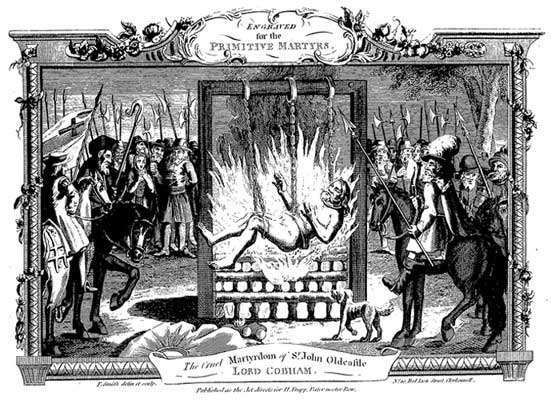
Since the condemned man was a Dominican and a doctor of theology, it seemed only natural to summon priests well-versed in canon law. But though these men sought to prove to the prisoner the error of his thinking, her persisted in what later would be described as his “cursed obstinacy.” Refusing to be discouraged, the fathers continued to remonstrate with him until the minister of justice arrived to conduct him to the stake.
Even then the members of the company of St. John and the others did not desert him. During the long march from the Tor di Nona they walked beside him, chanting litanies, urging him to kiss the painted tablets of the Crucifixion, pointing out his errors, and beseeching him to recant. But he ignored them, treating them like so many flies buzzing about his head and turning away from whichever friar happened to be reasoning with him at the moment.
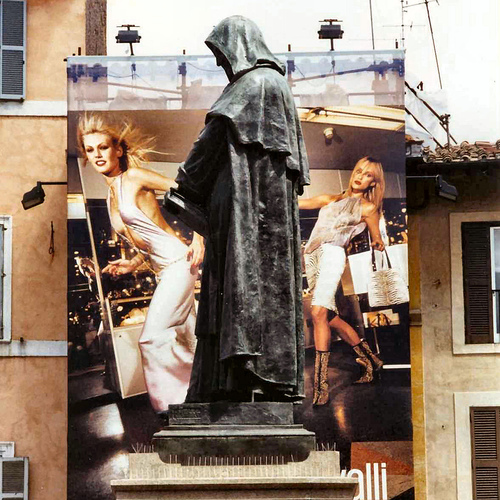
Smack in the center of the Rome's fashionable Campo de Fiori is a statue of Giordano Bruno, philosopher. Bruno held that God was present in nature and that the universe and life was infinite. The Catholic Church burned him at the stake, right where his statue is today. "The general opinion is not always the perfect truth..." Giordano Bruno is still quoted. Such remarks produced expensive, bitter consequences: On 17th of February 1600 he publicly was burnt at the stake after eight years of torture and dungeon detention. Today the Piazza Campo dei Fiori where this statue stands has become a monument to free thinking; adjacent to the statue, is the "Fahrenheit 451" bookstore, named after Ray Bradbury's 1953 novel expounding freedom of thought.
…”All things are one,” says Bruno. The soul of the universe is conceived of as intelligent, the ordinator of the world itself, the interior force of everything. Such a force is not transcendent, but immanent; it adheres in things. It is God, conceived of as “Natura naturans,” producing all and ordaining all to its end; it is infinite. The world, the work of “Natura naturans,” is “Natura naturata,” which, as the effect of an infinite cause, is also infinite.
Individual souls (and not only the human soul, but the soul of every individual essence, since for Bruno everything is animate) are the passing shades of the eternal becoming of the world. Bruno calls them monads. Birth is the individuation of the infinite in the finite; death indicates the return of the finite to the infinite….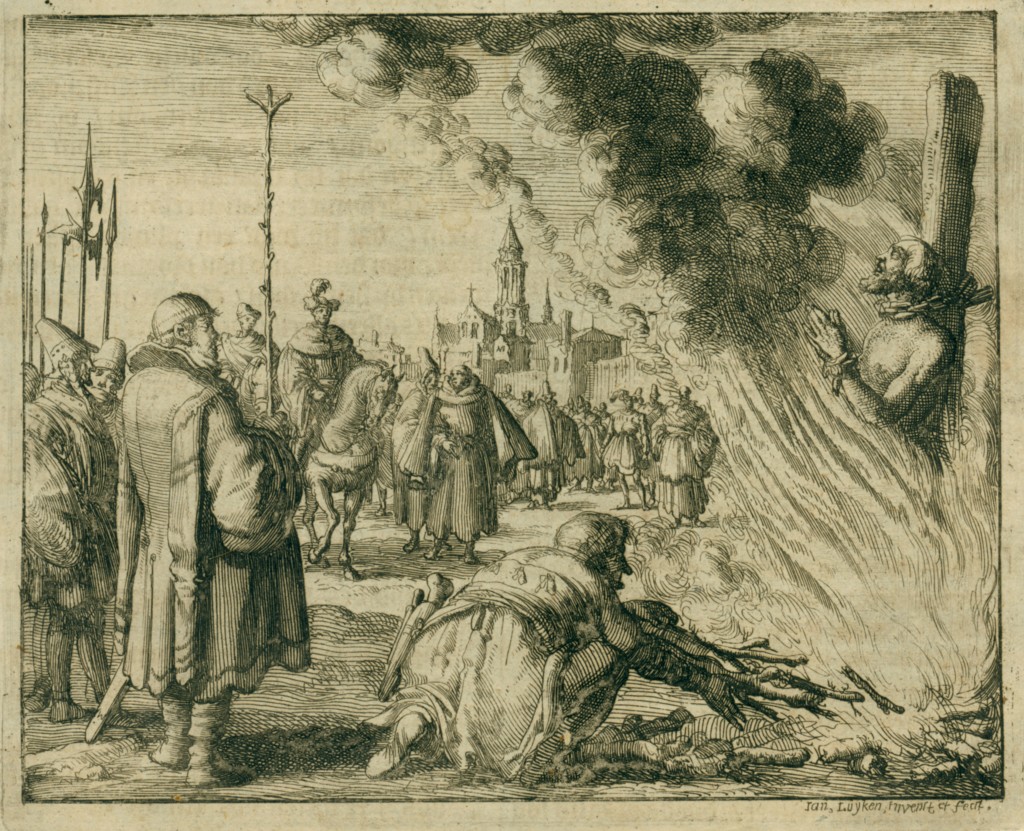
He was a thin, frail looking man of fifty-two, neither handsome nor ugly, with dark brown hair, a sparse black beard, and the livid, unhealthy complexion that comes from long years in prison. His feet were bare and his only piece of clothing was a sulfurous yellow penitents shirt painted with flames, devils, and a cross of Saint Andrew. As he came into view many members of the waiting crowd averted their gaze lest he give them the evil eye.
At the Campo dei Fiori he was stripped. A wedge was stuck in his mouth to keep him from uttering blasphemies as he died, and his nude body was bound to the stake. Once more the priests implored him to recant; once more he refused. Motioning for the crowd to stand back, the executioner applied a lighted torch to the pile of twigs and straw. A few of the spectators looked away, but most watched in greedy silence. Often, when a heretic felt the fire touch his body, weird subhuman moans could be heard forcing their way past the obstruction to his tongue.
… “In such a materialistic concept of the universe, any positive religion, including Christianity, is impossible. Religion for Bruno has practical but not theoretical value; it is an efficacious means of educating the ignorant masses through the symbolism of forms. Consequently, Bruno’s thought necessarily conflicts with the doctrine of the Catholic Church.
Bruno’s moral system is opposed to the teachings of the Catholic Church, but is consistent with his naturalistic immanentism. The end which man must realize is limited to the present life; it consists in the participation of the individual in the life of the universe. Virtue is not renunciation or asceticism but “heroic furor” — that is, the joyous consciousness of one’s own excellence and of one’s own participation in the life of the universe. The system of Bruno is a theoretical expression of Humanism, and his thought was to have a great influence on modern philosophy.” …
But Bruno remained impassive- further proof, if any were needed, that he was possessed by the devil. At the last moment the unhappy prisoner was offered a crucifix to gaze upon as he died. He rejected it with a wild and disdainful look. The orange flames spluttered and crackled, then turning a blinding yellow, and the acrid smell of burning flesh filled the morning air. Led by the friars, the vast crowd burst into song:”Great God, we praise Thee.”
That afternoon, as Bruno’s books were burned before the steps of the basilica in St. Peter’s Square, few must have bothered to glance at the titles: “On the Infinite Universe and Worlds”; “Of the Cause, Principles and Unity”. Certainly, none could have had any idea how much those works would influence future generations of philosophers and writers, from Spinoza to Leibnitz to James Joyce.
From his eighteenth year, as Bruno would later tell the judges of the Inquisition, he had doubted the doctrine of the Trinity. Nor was this all. His irrevocable vow of chastity, he now concluded, was “unreasonable and unnatural.” He was young; he was passionate. Why curb his perfectly natural instincts? Other aspects of romantic life also began to rankle. The fathers, who from afar had seemed such “godlike” men , on closer acquaintance proved to be “asses”
There was also the matter of Aristotle . Though the Dominicans considered Aristotle’s theories virtually the same as divine law, Bruno soon found himself rejecting Aristotle and instead turning for guidance to the less orthodox sources such as the Roman Lucretius. Whereas Aristotle declared that outside this world there is nothing, not even empty space, Lucretius described the universe as infinite. The trouble was that the Church considered Lucretius an atheist, since the earth centered universe of Aristotle was more consonant with Christian dogma.






 COMMENTS
COMMENTS
Fantastic Article David – You are really very talented and thoughtful in your discussions…
My favorite quote from this great man is “It is proof of a base and low mind for one to wish to think with the masses or majority, merely because the majority is the majority. Truth does not change because it is, or is not, believed by a majority of the people. “
thanks. talented and thoughtful may be an exaggeration; I can only guarantee an honest effort. I did not come across this quote yet, but it seems dead-on. Best
I recommend you a little book full of wisdom: Stories of Almanac by Bertolt Brecht,a collection of short stories; there is one about Giordano Bruno called “The cloak of the heretic”, where Brecht tells how Giordano Bruno struggled for his life for 8 years, from interrogation into interrogaton, while trying to pay to a tailor a cloak he still owed to him. Touching.
thanks for the information. I may have another article on him and this could help me. Best
I did miss Bruno but you didn’t! Thanks for bringing this to our attention. Good research, Dave.